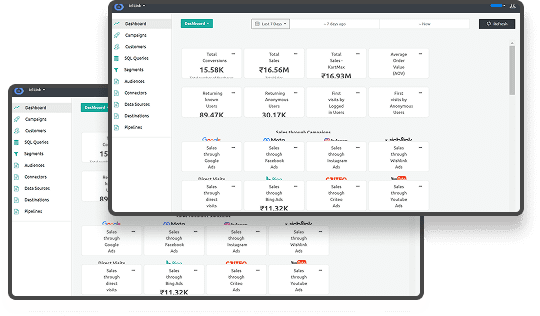TLDR
- Cookieless Personalization focuses on utilizing first-party data and privacy-friendly methods to deliver relevant user experiences without relying on third-party cookies.
- Key Strategies: First-party data, server-side tagging, contextual targeting, and identity solutions enable the maintenance of personalized experiences while respecting user privacy.
- Tools for Success: Tag management systems, CRM platforms, and identity resolution tools support seamless cookieless personalization.
- Challenges: Adapting to new privacy laws, ensuring accurate data, and maintaining user engagement require careful planning and the right tools.
How can businesses continue to deliver tailored experiences to their customers in a world where third-party cookies are becoming obsolete?
Over 30 million users have experienced a cookieless browsing environment, and this number is expected to rise as major browsers implement stricter privacy measures. This shift is prompting companies to rethink their marketing strategies, especially in the United States, where consumer expectations for personalized experiences remain high.
Despite the challenges, there is a significant opportunity for businesses that adapt to these changes. A study found that 64% of U.S. consumers prefer to purchase from companies that offer personalized experiences. However, many marketers are still behind in this transition. Additionally, 75% of marketers acknowledge the importance of real-time personalization, but only a fraction have effectively implemented it.
This gap underscores the need for businesses to adopt new strategies that prioritize user privacy while maintaining relevance and engagement. Hence, this article explores practical strategies for cookieless personalization, including the use of first-party data, server-side tagging, contextual targeting, and identity solutions.
What is Cookieless Personalization?
Cookieless personalization is the practice of customizing user experiences without relying on third-party cookies to track user behavior across different websites. Instead of relying on these external trackers, marketers use alternative methods to understand and engage their audience.
Unlike traditional personalization, which depends heavily on third-party cookies to gather data, cookieless personalization focuses on first-party data and other privacy-friendly techniques. This shift aligns with the industry's move towards more privacy-centric marketing, ensuring that user data is handled responsibly and transparently.
By adopting cookieless personalization, businesses can maintain effective marketing strategies while respecting user privacy and complying with regulations like GDPR and CCPA.
For a deeper understanding, refer to our article on 'How Cookieless Tracking Works and Its Impact on Data Collection'.
As we move forward, looking into the creative ways the brands have implemented personalization will show their effectiveness.
Innovative and Practical Ways Brands Are Implementing Personalization
As traditional tracking methods disappear, leading brands are showing that personalization doesn’t need to rely on third-party cookies to be impactful. By using first-party data, real-time signals, and contextual relevance, these companies are delivering experiences that feel tailored, without overstepping privacy expectations.
Adidas: Personalizing by Activity and Style Preferences
Adidas personalizes product recommendations on its site and in-app based on what users browse, buy, or filter for, be it running, training, or casual wear. Once a user interacts with a category, subsequent visits highlight gear aligned with that activity. The strategy goes beyond pushing bestsellers; it adapts visuals, messaging, and product bundles based on individual interests, all derived from on-site behavior, not third-party tracking.
Starbucks: Custom Offers Through First-Party App Engagement
Starbucks uses its loyalty app to deliver highly tailored promotions based on a user’s purchase history, time of visit, and even local weather conditions. For example, frequent afternoon visitors might receive mid-day drink offers, or users in warmer cities could get personalized cold drink promotions. Because all data is collected within the Starbucks app ecosystem, this personalization is entirely cookieless and opt-in.
Amazon Prime Video: Watchlist-Based Interface Customization
Amazon tailors the layout of Prime Video depending on user behavior. If someone watches mostly comedies, the top row of the homepage may highlight trending comedy releases. If another user binge-watches international dramas, they'll see genre-specific playlists and language-based recommendations. These real-time interface changes are driven solely by viewing history; no external tracking is required.
Nike: Personalized Fitness Journeys Inside Its Apps
Nike Training Club and Nike Run Club apps adapt fitness plans based on user goals, training frequency, and performance. If a user logs morning runs and short workouts, the app highlights warm-up routines and tailored recovery suggestions. This isn’t just product-focused personalization, it’s functional guidance based on first-party data input by the user and captured within Nike’s ecosystem.
Sephora: Contextual Email Campaigns Based on Skin Profiles
Sephora combines quiz data, browsing behavior, and past purchases to personalize not only products, but also routines. Emails are tailored to content based on factors such as skin type, preferred brands, and seasonal needs. For example, someone with dry skin may get a cold-weather skincare guide in winter. This behavior-based personalization is deeply relevant, and fully cookieless.
These brands show that high-impact personalization doesn’t need to be invasive. They use first-party insights to shape interfaces, campaigns, and experiences that feel uniquely relevant, without relying on external trackers.
Now, let's move on to study about various effective strategies to tackle it.
Strategies for Cookieless Personalization
Adapting to a cookieless environment requires innovative strategies. Here are four straightforward approaches to achieve effective cookieless personalization:
1. Use First-Party Data
First-party data is information you collect directly from your audience, such as website interactions, purchase history, and user preferences. This data is invaluable because it’s reliable and compliant with privacy regulations.
How to Collect:
- Surveys and Feedback: Encourage users to share their preferences through surveys and feedback.
- User Accounts: Offer incentives for users to create accounts and provide detailed information.
- Engagement Tracking: Monitor how users interact with your website and content.
Leveraging first-party data enhances personalization while respecting user privacy. Solutions like Ingest ID help you create a first-party identity for every unique visitor to your website and mobile app. It becomes easy to understand your visitors, whether they are first-time or recurring. You can use the identity details to personalize the experience without relying on third-party cookies.
Learn more about Crafting Unique Experiences with First-Party Data.
2. Implement Server-Side Tagging
Server-side tagging shifts the data collection process from the user's browser to your server. This method reduces reliance on third-party scripts, improving data accuracy and privacy.
Steps to Start:
- Set Up a Server: Establish a server environment to handle data collection.
- Migrate Tags: Move your existing tags from the client side to the server.
- Test and Optimize: Ensure data is being collected accurately and make necessary adjustments.
Server-side tagging not only boosts data privacy but also enhances website performance. Discover more about Server-Side Tagging: Why It's Time to Shift the Game. Solutions like Ingest IQ help set up server-side tracking to work seamlessly despite cookie restrictions and the presence of Ad blockers, ensuring no signal loss.
3. Focus on Contextual Targeting
Contextual targeting involves delivering ads based on the content a user is currently viewing, rather than their past behavior. This method respects privacy while still providing relevant and timely advertisements.
Advantages:
- Privacy-Friendly: No need for tracking user behavior across sites.
- Relevance: Ads are more likely to resonate because they match the current context.
- Higher Engagement: Users are more likely to engage with ads that are relevant to their current interests.
For more information, read our article on Understanding Addressable Advertising: Importance and Benefits.
4. Utilize Identity Solutions
Identity solutions help track users across different devices by creating a unified user profile based on multiple identifiers, such as email addresses or device IDs. Consider using Ingest ID. A first-party identifier is assigned to each unique visitor of a website or mobile app, ensuring consistent tracking throughout their journey over extended periods. This enables accurate attribution and a comprehensive understanding of the customer experience
How to Integrate:
- Choose a Reliable Identity Provider: Select a provider that offers robust identity resolution tools.
- Sync Data Sources: Combine data from various channels to build a comprehensive user profile.
- Maintain Privacy: Ensure all identity solutions comply with relevant privacy regulations and protect user data effectively.
By using identity solutions, you can maintain a cohesive understanding of your audience without relying on third-party cookies. Learn how to Track the Customer Journey Across Multiple Channels with Ingest Labs.
With strategies in place, let's examine the tools that can facilitate cookieless personalization.
Tools for Cookieless Personalization
To implement cookieless personalization effectively, marketers need to use tools that prioritize privacy while still delivering relevance. As third-party cookies phase out and regulations tighten, these technologies provide a compliant, high-performance alternative for collecting, managing, and activating data.
1 Tag Management Systems
Tag management systems help you manage and deploy tags without relying on third-party cookies. Platforms like Ingest IQ simplify this by enabling server-side deployment, reducing browser load and data leakage while preserving event tracking accuracy.
2 Server-Side Tracking
Server-side tracking moves data collection from the browser to your server environment. This improves performance, strengthens data security, and reduces reliance on client-side cookies that are often blocked or deleted.
With Ingest IQ, businesses can shift Facebook CAPI, Google Ads, and other integrations server-side while maintaining real-time visibility and granular control over data flows.
3 First- and Zero-Party Data
While first-party data comes from user actions like clicks or purchases, zero-party data is explicitly shared by users—think surveys, preference centers, or onboarding quizzes. This data is both accurate and privacy-safe, since users voluntarily offer it.
Platforms like Ingest ID help build persistent first-party identity graphs that can incorporate zero-party inputs, enabling long-term personalization without surveillance.
4 Customer Relationship Management (CRM) Platforms
CRMs centralize user data, making it easier to understand your audience, segment communications, and personalize experiences across channels. By syncing CRM data with marketing platforms (via APIs), you maintain relevance without tracking users across the web.
5 Conversions API (CAPI)
Conversions APIs allow you to send event data directly from your server or CRM to platforms like Meta or Google, bypassing reliance on browser cookies. This improves the accuracy of conversion tracking and ensures better optimization of ad campaigns.
Ingest Labs integrates natively with platforms such as Meta CAPI and Google Enhanced Conversions, making server-to-platform data sync seamless and privacy-compliant.
6 Contextual Advertising Engines
Contextual targeting matches ads to the content of a page rather than the user's browsing history. For instance, a travel brand advertising on an article about backpacking doesn’t need to know anything about the visitor; it simply aligns with the page topic.
7 Advanced Analytics Platforms
Analytics platforms help you extract insights from your first-party data, enabling better segmentation, experimentation, and content optimization. The key is real-time processing and signal consistency—something that’s harder to achieve without third-party cookies.
Tools like Ingest IQ’s real-time data streaming offer deeper visibility into event-level behavior, letting marketers respond quickly with content adjustments or triggered campaigns.
8 Identity Resolution Tools
As users engage across channels, identity resolution tools unify fragmented data points into a single profile using first-party identifiers like emails, device IDs, or login data. This improves attribution and allows personalization across web and mobile without relying on cross-site trackers.
Ingest ID builds durable, compliant identity graphs that allow accurate targeting over long user journeys, even in anonymous sessions or across devices.
9 Privacy Management Platforms
To maintain compliance with privacy laws like GDPR or CCPA, privacy management tools manage user consent, automate data request handling, and enforce data access policies.
Ingest Labs embeds privacy controls within its platform, ensuring that data governance, audit trails, and environment-specific settings are integrated into your personalization workflows.
Choosing the right tools ensures seamless integration with your existing marketing stack, making cookieless personalization manageable and effective.
Ingest Labs stands out as a comprehensive solution for cookieless personalization. With over 100+ pre-built integrations, it seamlessly connects with various marketing tools and platforms like Meta CAPI, TikTok Events API, and Google Measurement API. Additionally, Ingest Labs offers real-time data streaming and tag monitoring, providing deeper insights into user behavior and optimizing campaigns effectively. Consider using Ingest Labs to streamline your cookieless personalization efforts.
Also Read: Real-Time Data Streaming Unlocked for real-time analytics insights.
Next, let's address how to overcome the challenges in a cookieless world.
Challenges and its Solutions in a Cookieless World
Navigating a cookieless world isn’t easy, but with the right strategies and tools, you can overcome common challenges. Here’s how you can address these issues effectively:
1. Data Privacy and Compliance
Challenge:
Meeting strict data privacy laws like GDPR and CCPA while collecting and managing user data.
Solution:
Implement data privacy frameworks that ensure compliance with regulations. This involves obtaining explicit user consent, maintaining transparent data practices, and regularly auditing data collection processes.
For a deeper understanding, refer to our Understanding the General Data Protection Regulation (GDPR) guide.
2. Technical Complexity of Server-Side Tagging
Challenge:
Implementing server-side tagging can be technically demanding.
Solution:
Simplify the transition by utilizing user-friendly platforms that offer comprehensive support and pre-built integrations. Ingest Labs provides solutions that make server-side tagging implementation smoother without requiring extensive technical expertise.
Learn more in our Server-Side Tagging: Why It's Time to Shift the Game article.
3. Integration with Multiple Marketing Tools
Challenge:
Ensuring seamless integration with various marketing tools and platforms.
Solution:
Utilize tag management systems that provide a broad range of integrations to unify your marketing stack. This ensures efficient data flow across all channels, preventing data silos and enhancing overall marketing effectiveness. Ingest Labs boasts over 100 pre-built integrations, connecting with tools such as Meta CAPI, TikTok Events API, and Google Measurement API.
Explore more in Top Demand-Side Platforms for Programmatic Advertising in 2024.
4. Maintaining Website Performance
Challenge:
Third-party scripts can slow down your website, leading to higher bounce rates.
Solution:
Optimize your website's performance by minimizing client-side scripts and adopting server-side tagging. This reduces load times and improves user experience, which are crucial for maintaining high conversion rates.
For practical strategies, refer to our article, "Site Slowing Down?" Strategies to Improve Pagespeed.
5. Real-Time Data Processing
Challenge:
The need for real-time data processing to make timely marketing decisions.
Solution:
Implement real-time data streaming and analytics to gain instant insights into user behavior and market trends. This enables you to respond swiftly and keep your personalization efforts relevant.
Discover more in our Real-Time Data Streaming Unlocked guide.
6. Ensuring Accurate Data Collection
Challenge:
Without proper tag management, data collection can be prone to errors, resulting in inaccurate insights.
Solution:
Utilize tag monitoring and alert systems to identify and resolve tag errors. Reliable tag management ensures your data collection processes are accurate and your insights are trustworthy.
Discover Proactive Monitoring Strategies to ensure data accuracy.
7. Adapting to Evolving Privacy Regulations
Challenge:
Keeping up with the ever-changing landscape of privacy laws across different regions.
Solution:
Stay informed about global privacy regulations and continuously update your data practices to comply with new laws. Ingest Labs regularly updates its tools to adhere to the latest regulations, including Understanding LGPD: Brazil’s General Personal Data Protection Law and Understanding the Personal Information Protection and Electronic Documents Act: PIPEDA Compliance in Canada, ensuring your business remains compliant globally.
8. Balancing Personalization with User Privacy
Challenge:
Delivering personalized experiences without compromising user privacy.
Solution:
Leverage first-party data and privacy-first technologies to achieve effective personalization while respecting user privacy. Implement ethical data collection practices that build trust with your audience.
Explore How Ethical Data Collection Builds Trust and Fuels Business Growth for strategies on ethical data management.
By addressing these challenges with practical solutions, businesses can successfully navigate the transition to cookieless personalization and continue to effectively engage their audience.
For more information, refer to the article "Third-Party Cookie Restrictions: Challenges and Solutions."
Conclusion
Adapting to cookieless personalization is no longer optional for digital marketers it's a necessity. As third-party cookies fade away, adopting new strategies ensures your marketing remains effective, personalized, and compliant with privacy regulations.
By utilizing first-party data, implementing server-side tagging, focusing on contextual targeting, and leveraging identity solutions, you can maintain high-quality personalization while preserving user privacy. Additionally, the right tools and proactive solutions will help you overcome the challenges of a cookieless world.
Ingest Labs stands out as a key partner in this journey, offering comprehensive solutions that address the unique challenges of a cookieless environment. From tag management to seamless integrations and real-time data streaming, Ingest Labs provides the tools you need to keep your marketing campaigns optimized and your personalization efforts on point.
Ready to navigate the future of personalization? Contact us today to discover how Ingest Labs can support your transition to cookieless personalization and help you achieve marketing success.
FAQ
1 What is the cookieless approach?
The cookieless approach involves tracking and collecting data without using cookies, focusing on privacy-compliant methods. It relies on alternatives, such as first-party data and server-side tracking.
2 What are personalization cookies?
Personalization cookies store data about user preferences to deliver tailored content and ads. They help create customized experiences for users based on their interactions with a website.
3 What is the difference between cookieless and cookie?
Cookies store data on a user's device to track their activity, while cookieless tracking avoids using cookies and employs methods like server-side tracking and contextual targeting.
4 What is the impact of a cookieless world?
A cookieless world challenges traditional digital marketing and data collection methods. It requires businesses to adopt new privacy-compliant tracking and targeting strategies.
5 How to prepare for a cookieless future?
Prepare by focusing on first-party data, implementing server-side tracking, and using consent-based methods. Additionally, consider shifting to contextual advertising and building stronger customer relationships.






